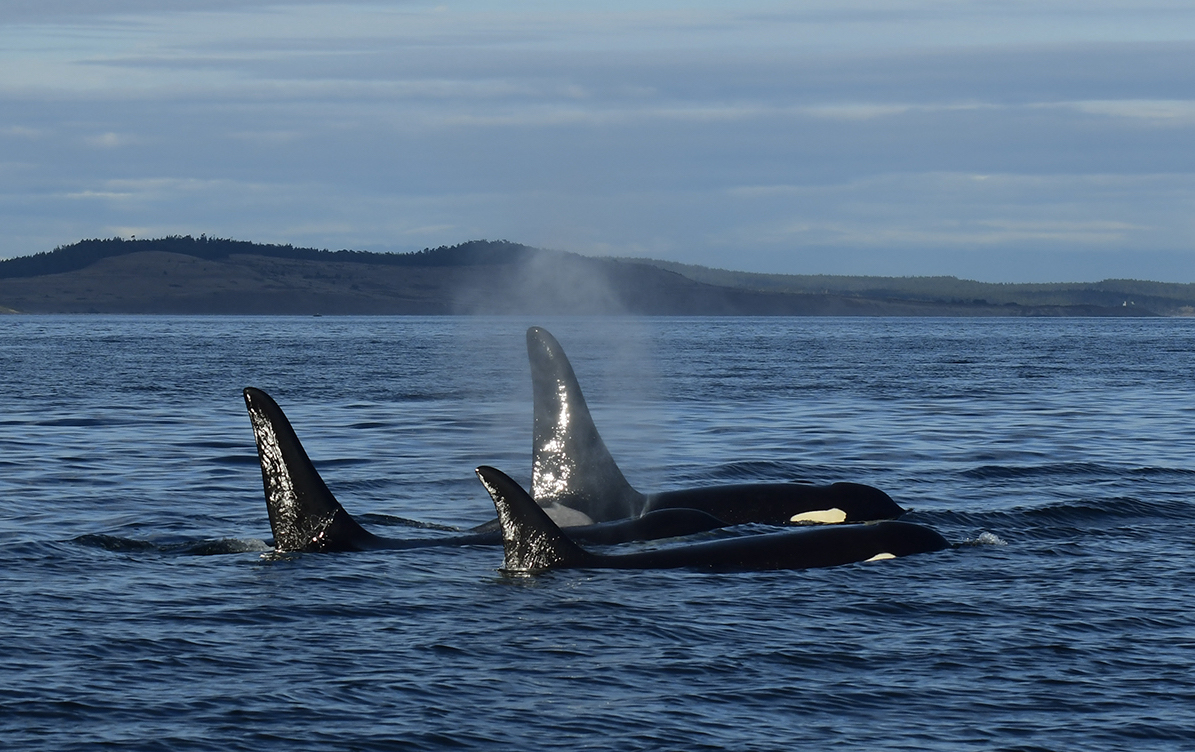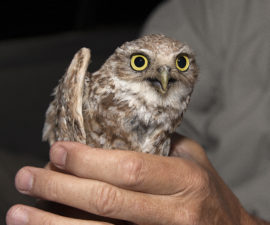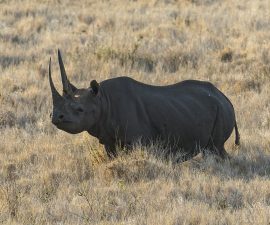BY Elyan Shor, Ph.D.
Data collection is the first step in devising any conservation intervention; without adequate information about the problem, we will not be able to implement an effective solution. Lack of data—including information about appearance, behavior, physiology, and genetics—is a common conservation obstacle for species that are difficult to locate, see, or follow. If these species have low population numbers, data collection becomes even more difficult. This is the challenge facing scientists that study Southern Resident killer whales.
As if gathering information about a species that lives entirely underwater isn’t hard enough, there are now less than 75 Southern Resident killer whales remaining in their native waters, meaning that very limited data about the health of these animals has been collected—until now. Using innovative technology, San Diego Zoo Wildlife Alliance and our partners are gaining unprecedented insights into killer whale health and well-being.
Trouble in the Water
Killer whales (Orcinus orca; also called orcas) are an iconic apex predator and a focus of San Diego Zoo Wildlife Alliance’s Oceans Conservation Hub, through which we work to foster thriving marine wildlife, communities, and ecosystems. Southern Resident killer whales live in the Salish Sea, a body of water along the Pacific coast tucked in by the Olympic Peninsula (Washington, USA) and Vancouver Island (British Columbia, Canada). The whales face several threats due to human activity in this region. Coastal and freshwater habitat modification, as well as overfishing, have dwindled the stocks of fish in the Salish Sea—a catastrophic problem for Southern Residents because they are fish specialists, and the abundance of their preferred prey, Chinook salmon, has declined precipitously. Additionally, noise pollution caused by recreational and commercial boat traffic can disrupt orca behavior. And chemical pollutants—generated from industry and agriculture and dumped or drained into the sea—can compromise killer whale reproductive and immune function.
But just as multiple threats endanger Southern Resident killer whales, there are multiple reasons why we must commit to protecting them. Orcas have an important place in the cultural fabric of local communities: for thousands of years, Indigenous peoples have respected and cherished them as family members, and today, these whales form part of the core identity of this entire geographic region. Further, killer whales are intelligent and social, and we have much yet to learn from them about the evolution of complex behavior and sociality in mammals. And critically, killer whales are an indicator species: their health reflects the health of the ecosystem that supports them, and both wildlife health and ecosystem health directly affect human health.
Launching a Solution
San Diego Zoo Wildlife Alliance is part of a multi-partner effort to conserve Southern Residents, led by the National Oceanic and Atmospheric Administration (NOAA). Together, our conservation scientists and veterinarians are working to regularly monitor killer whales so that we can assess their individual health in real time and proactively implement medical interventions if necessary. Historically, gathering orca health data would require collection of tissue or blood samples, but acquiring these types of samples in open water is extremely difficult for scientists and can be stressful for the animals.
To avoid disturbing the Southern Residents, our team decided to collect orca breath, as it can be sampled noninvasively, and it can provide an important snapshot of every individual’s health. Killer whales exhale a cloud-like plume of breath from the blowhole when they surface; but unlike the enormous breath sprays produced by the larger, baleen whale species, orca breath plumes reach just a few feet in height and only linger in the air for a few seconds. So how do our scientists go about collecting such a low-volume and short-lived material? With a flying petri dish, of course!

San Diego Zoo Wildlife Alliance has a proven record of success in using drones for conservation, and we knew drones would be the ideal vehicle to help us spot and gather the elusive breath samples. But in the world of conservation, off-the-shelf products don’t always meet the exacting demands of a challenge at hand; rather, some creative adaptation is required to convert standard devices into bespoke tools.
To transform a ready-made drone into a whale breathalyzer, our team scanned the drone into a computer and designed a made-to-measure mount that holds two petri dishes. We then 3D-printed the mount and attached it to the drone alongside a video camera. This novel setup allows us to aerially locate the whales and fly the drone through a breath plume to collect breath droplets on the petri dishes—all without disturbing the animals and remaining at a comfortable distance.
Droning On
Strict permitting conditions must be met when operating a drone: our experienced pilots are certified by the Federal Aviation Administration, and additional approvals from NOAA allow us to operate a drone near marine wildlife. Further, at the onset of our study, our team submitted video recorded by our drone cameras to experts in killer whale behavior—these experts analyzed the videos and confirmed that while some orcas may be aware of the presence of the drone, neither the drone nor the breath collection disrupts their behavior.
With our approved custom drone in hand, our team and partners head out to sea in a small boat operated by NOAA. The drone can operate as far as 10 kilometers away from the boat, 180 feet above the water, and stay airborne up to 45 minutes; as it flies, it sends a live video feed back to the boat. Once a group of whales has been spotted, our drone pilot navigates the drone into a low position near the whales, ready to zip into a breath cloud as soon as an orca surfaces. But this maneuver is more easily said than done: we have just seconds to collect the droplets, the drone needs to be navigated with exceptional aim to gather as much of the sample as possible, and the pilot must steer straight while standing on a moving boat.

The spritzed petri dishes are taken to a laboratory run by the UC Davis SeaDoc Society for breath sample processing. Scientists in the lab can then extract information about cells, viruses, bacteria, and fungi present in an orca’s respiratory tract. These data clarify whale health at the individual and population level, and wildlife health professionals can use these health metrics to inform medical interventions if an animal is showing signs of sickness. With less than 75 Southern Residents remaining, every individual matters, and we can now step in to protect these endangered killer whales before it’s too late.
Modern Methods
Gathering breath samples is one of several methods applied in our collaborative effort to better understand killer whale health and to create a repository of wildlife health records accessible to scientists working in the Salish Sea and beyond. Video footage from our drone cameras is providing new perspectives on orca behavior. Alongside our partners, we are also trialing the use of thermal infrared cameras mounted on drones to measure killer whale internal body temperature via the blowhole—this is the first time these cameras have ever been used in this way. Additionally, together with collaborators, we are collecting killer whale fecal samples and analyzing them to monitor parasitism, pregnancy status, inflammation, and gut health.
Collectively, these novel technologies and applications will enable NOAA and other local partners to regularly analyze comprehensive killer whale data. Remote data collection has the benefit of effectively gathering information without risks to wildlife, and the resulting health data will inform conservation action for killer whales and the Salish Sea ecosystem. This approach can also be applied to study and protect other whale and dolphin species—along with their oceans—around the world. San Diego Zoo Wildlife Alliance’s contributions to these efforts underscore our commitment to meeting complex challenges with innovative solutions and reflect our leading expertise in conservation technology, wildlife science, and wildlife health worldwide.
Image at top: Southern Resident killer whales (Photo credit | Maya Sears, NOAA | NMFS ESA Permit #21348)





